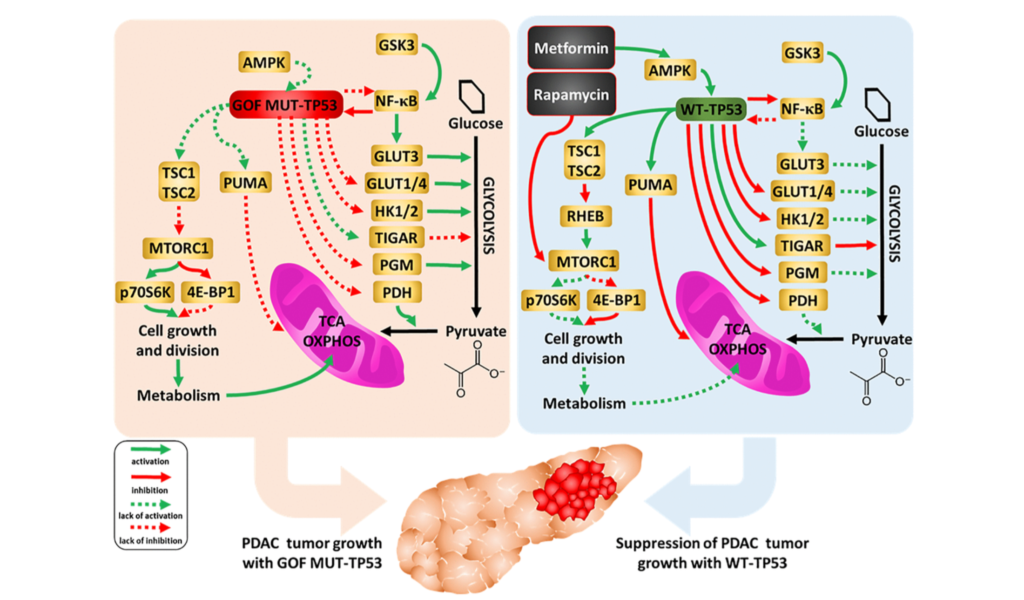Patients over the age of 50 years old who have been diagnosed with pancreatic cancer have a poorer rate of survival compared to younger patients. This means that pancreatic cancer is a disease associated with aging. The most common type of pancreatic cancer is pancreatic ductal adenocarcinoma (PDAC) and it is frequently diagnosed in its later stages.
PDAC is often refractive to chemotherapies and develops resistance to inhibitors and other drugs. Therefore, there is a critical need for researchers to discover novel strategies to overcome drug resistance in PDAC cells. One potential strategy is to focus on a key gene known for its involvement in many cell processes, including drug resistance and metabolism: TP53. The TP53 gene is often mutated or deleted in cancer cells, which can lead to drug resistance and cancer metastasis. In PDACS, this tumor suppressor gene has been shown to be mutated in 50–75% of patients.
“Many genes have been implicated in PDAC including KRAS, TP53, CDKN2A, SMAD4 and PDGFβR [3, 8, 9, 18–22].”
In a new study, researchers—from Brody School of Medicine at East Carolina University, Università di Bologna, University of Parma, and University of Wroclaw—further elucidated TP53’s role in drug resistance in PDAC cells. On April 27, 2022, their research paper was published in Aging (Aging-US) on the cover of Volume 14, Issue 8, and entitled, “Wild type and gain of function mutant TP53 can regulate the sensitivity of pancreatic cancer cells to chemotherapeutic drugs, EGFR/Ras/Raf/MEK, and PI3K/mTORC1/GSK-3 pathway inhibitors, nutraceuticals and alter metabolic properties.”
The Study
In these in vitro studies, the researchers cultured two different PDAC cell lines. One cell line had a gain of function (GOF) TP53 mutation (MIA-PaCa-2) and the other had a loss of TP53 (PANC-28). Both PDAC cell lines also have activating mutations in the KRAS gene. Next, the team introduced either wild-type TP53 (WT-TP53) or a control vector into both PDAC cell lines. Effects from this experiment were analyzed using 26 clinically approved agents.
The chemotherapeutic drugs included: Docetaxel, 5-fluorouracil (5-FU), gemcitabine, Aclacinomycin, Doxorubicin, and Cisplatin. The signal transduction inhibitors included: ARS-1620, PD0325901, LY294002, Pifithrin-μ, 6-bromoindirubin-30-oxime (BIO), SB415286, CHIR99021, Rapamycin, AG1498, Gilteritinib, Sorafenib, OTX008, Tiplaxtinin, Verapamil, and Vismodegib. The natural products included: Cyclopamine, Parthenolide2, Isoliquiritin2, Genistein2, and Daidzein2. The researchers also illustrated the effects of WT-TP53 and mutant TP53 on PDAC cell metabolism with metformin and rapamycin.
“An overview of the effects of WT and mutant TP53 on metabolic properties, together with the effects of metformin and rapamycin, and drugs used to inhibit pancreatic cancer growth, is presented in Figure 16.”

The Results
The researchers found that, in the presence of chemotherapeutic drugs, PDAC clonogenicity was decreased by the restoration of WT-TP53. Overall, the restoration of WT-TP53 in PDAC cells increased sensitivity/decreased resistance to various chemotherapeutic drugs, inhibitors and natural products. WT-TP53 also influenced PDAC cell metabolic properties, including their metabolism. The authors also noted that the activity of mTORC1 (target of rapamycin), which is important in cellular growth and metabolism, can be affected by mutant TP53. They found that GOF mutated TP53 may render PDAC cells more resistant to rapamycin.
“Rapamycin and metformin can interfere with some of the important pathways in the mitochondria, some of which are regulated by TP53 [96–98].”
Conclusion
Overall, these results suggest that WT-TP53 can play a key role in PDAC cell sensitivity to multiple drugs used to treat pancreatic cancer. Further studies are needed to better understand the mechanisms underlying the effects of TP53 on drug resistance and metabolism in PDAC cells, as well as its clinical implications.
“Regardless of which of the above processes contributes more to the reduction of mitochondrial metabolism in comparison with the same cells that only express GOF TP53, together the observed changes suggest restoration of WT-TP3 activity confers increased sensitization to various drugs and therapeutic molecules, natural products as well as nutraceuticals.”
Click here to read the full research paper published by Aging (Aging-US).
AGING (AGING-US) VIDEOS: YouTube | LabTube | Aging-US.com
—
Aging (Aging-US) is an open-access journal that publishes research papers bi-monthly in all fields of aging research. These papers are available at no cost to readers on Aging-us.com. Open-access journals have the power to benefit humanity from the inside out by rapidly disseminating information that may be freely shared with researchers, colleagues, family, and friends around the world.
For media inquiries, please contact [email protected].
